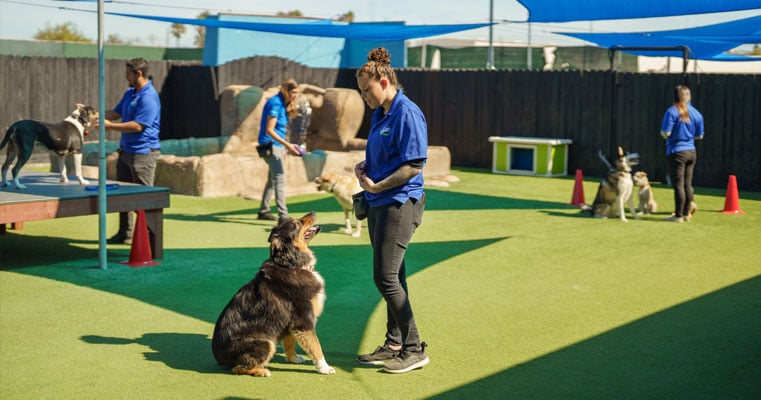Unlock Your Pet dog's Prospective: Proven Canine Training Methods for Success
Effective dog training is a nuanced process that pivots on recognizing canine behavior and using medically backed methods. By incorporating favorable support, developing clear commands, and focusing on socialization, dog owners can cultivate an effective connection with their pets.
Comprehending Dog Habits
Comprehending canine habits is important for effective training and cultivating a favorable relationship between pets and their owners. A detailed understanding of canine body language, vocalizations, and social communications is essential for identifying their emotions and needs. Pet dogs interact mostly via non-verbal hints; for instance, a wagging tail might show excitement, while pinned ears can signal concern or entry.

Additionally, ecological aspects play a substantial role fit a dog's habits. Changes in routine, brand-new surroundings, or the existence of strange people can result in anxiety or anxiousness in dogs. Identifying these triggers makes it possible for proprietors to reduce damaging responses and develop appropriate training strategies.
Inevitably, a deep understanding of dog actions lays the structure for effective training approaches, boosting both actions and the total bond in between the pet and its proprietor. Dog training. This expertise is essential for cultivating a well-adjusted, happy canine companion
Positive Reinforcement Strategies
Efficient training relies greatly on positive support techniques, which have been revealed to yield significant cause forming desired actions in canines. This method entails rewarding a pet for exhibiting details actions, consequently boosting the probability that these behaviors will certainly be duplicated. Incentives can take different types, including deals with, praise, toys, or playtime, depending upon what inspires the specific dog.

It is necessary to gradually phase out incentives as the pet finds out the actions, transitioning to recurring support. This approach preserves the actions gradually while avoiding reliance on consistent incentives. By concentrating on favorable support, trainers can grow a trusting connection with their canines, promoting a healthy and balanced and cooperative training setting that enhances general obedience and efficiency.
Establishing Constant Commands
A basic aspect of effective pet training is the establishment of constant commands. Uniformity in commands is vital for reliable interaction in between the dog and the instructor. When commands are uniform, dogs find out to link specific words with wanted behaviors, which accelerates the training process and boosts understanding.
To develop regular commands, it is important that all member of the family use the very same terms and motions. As an example, if one person makes use of "rest" while an additional says "rest down," it can develop confusion for the pet dog. Select clear, distinct words for commands and make certain everybody entailed in the dog's training sticks to these selections.
Reinforce commands via frequent technique, ensuring that the canine receives enough opportunities to respond appropriately. When a pet efficiently complies with a command, prompt positive support ought to comply with.
Finally, be patient. Establishing consistent commands requires time and initiative. With commitment and clarity, you will assist your pet create a solid understanding of assumptions, ultimately bring about a well-behaved friend.
Socialization and Exposure
Interacting socially a pet is necessary for fostering a well-adjusted and certain buddy. This procedure includes subjecting your pet to a range of settings, individuals, and other pets to establish their social skills and versatility. Early socialization, preferably between the ages of three to fourteen weeks, is critical, as it prepares for a pet's future actions.
During socializing, aim to give positive experiences in various settings, such as parks, busy roads, and homes with other family pets. Introduce your canine to various stimuli, including audios, sights, and scents, ensuring that each experience is fulfilling. This direct exposure assists alleviate concern and stress and anxiety, terroux dog training paving the way for an extra durable canine.
Involving in regulated group play sessions with other pet dogs can also enhance social abilities, instructing your family pet appropriate interactions and borders. Focusing on socializing will dramatically contribute to your dog's general happiness and behavior throughout their life.
Conquering Common Educating Obstacles

Another constant problem is distraction. Pets may battle to concentrate in busy or unfamiliar setups. Progressively desensitize your pet to interruptions by starting training in a silent atmosphere and gradually introducing even more stimuli as they come to be competent (dog training charlotte nc). Positive reinforcement techniques, such as deals with and praise, can maintain motivation and emphasis.
In addition, behavioral problems like jumping or extreme barking can come to be irritating. Address these by teaching alternate behaviors, such as resting steadly when greeting visitors. Uniformity and persistence are critical; enhance desired habits continually and prevent abuse, which can cause complication.
Lastly, recognize that each pet is unique, and training timelines might vary. Tailor your approach to your pet dog's specific demands, and seek professional assistance if essential. With perseverance and the appropriate strategies, getting over these obstacles can lead to a trained, pleased canine buddy.
Conclusion
In conclusion, opening a canine's possible demands a thorough technique that integrates an understanding of canine habits, the application of positive support methods, and click for more the establishment of consistent commands. Early socializing and exposure to diverse settings further boost a pet's flexibility and self-confidence. By resolving typical training challenges with tailored methods and persistence, a unified and cooperative connection between pet and handler can be cultivated, inevitably leading to a mannerly buddy efficient in thriving in various scenarios.
Efficient dog training is a nuanced procedure that pivots on understanding canine actions and using clinically backed strategies.Recognizing canine actions is necessary for effective training and promoting a favorable connection between dogs and their proprietors.Effective training relies heavily on favorable support techniques, which have actually been shown to produce considerable results in shaping wanted habits in pets. When commands are uniform, canines find out to link particular words with desired behaviors, which accelerates the training procedure and boosts understanding.
In verdict, opening a dog's potential requires a thorough technique that includes an understanding of canine habits, the application of positive support techniques, and the facility of consistent commands.